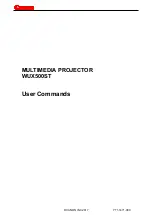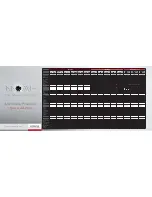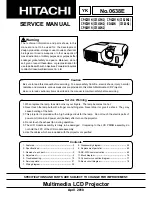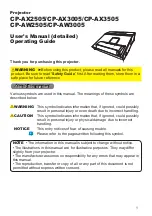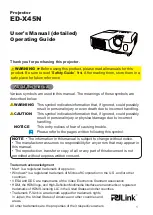
7. ICMP
7.2
ICMP HDD
About ICMP HDD
The three HDDs (local storage) in the ICMP, are set up in a RAID 5 con
fi
guration. This storage technique, that combines multiple
HDD components into a logical unit, manages enough redundancy information to continue to operate properly after the loss of one
HDD.
Image 7-6
C
AUTION
:
A RAID 5 con
fi
guration with three HDDs allows a maximum loss of one disk. With the simultaneous
loss of more than one HDDs, data is lost and the RAID must be completely initialized again after replacement
of the defect HDDs with new HDDs!
About degraded mode
When a RAID array experiences the failure of one disk, it enters in degraded mode. Content storage and playback remains available
on the ICMP.
C
AUTION
:
The loss of one disk causes no serious consequences on the ICMP. But action must be taken
quickly because the loss of a second disk will make the RAID system broken. The main cause of the total loss
of RAID is due in most cases to the loss of the second disk while the
fi
rst has not been rebuilt!
A failed drive should be replaced as soon as possible.
About “RAID recovery” process
The restoration from degraded to normal condition of the RAID 5 system is done automatically. When the RAID controller detects a
new HDD to replace the failed disk the recovery procedure starts automatically.
C
AUTION
:
The automatic process does not work if more than one disk is lost. In that case the RAID must be
completely initialized again!
About RAID broken
When more than one HDD is out of order, the RAID is considered as ’broken’ and the content is lost. The failed HDDs must be
changed and a new RAID must be created.
Exchange or re-use of a disk set
It’s possible to have several sets of disks with one ICMP or to reuse a complete set of disks coming from another projector with
ICMP. It is suf
fi
cient to insert the three HDDs, from a valid RAID array, and let the system explore the new RAID. The mounting order
of the HDDs and the HDD slots do not matter. Of course, when using HDDs from another ICMP it is necessary to retrieve from the
content distributor the KDMs corresponding to the content and the new ICMP.
HDD storage capacity
Make sure that all HDDs in the ICMP HDD set have the same storage capacity. See label on top of the HDD to know the storage
capacity.
HDD storage
The maximum recommended storage period for the drive in a non-operational environment is 90 days. Drives should be stored in the
original unopened shipping packaging whenever possible. Once the drive is removed from the original packaging the recommended
maximum period between drive operation cycles is 30 days. During any storage period the drive non-operational temperature,
humidity, wet bulb, atmospheric conditions, shock, vibration, magnetic and electrical
fi
eld speci
fi
cations should be followed.
56
R5906847 DP2K SLP SERIES 02/06/2017
Summary of Contents for DP2K SLP Series
Page 1: ...DP2K SLP Series User and Installation manual R5906847 00 02 06 2017 ...
Page 4: ......
Page 15: ...1 Safety PR RESTRICTED AREA RESTRICTED AREA Image 1 2 R5906847 DP2K SLP SERIES 02 06 2017 11 ...
Page 18: ...1 Safety 14 R5906847 DP2K SLP SERIES 02 06 2017 ...
Page 44: ...5 Lenses Lens selection 40 R5906847 DP2K SLP SERIES 02 06 2017 ...
Page 86: ...7 ICMP 82 R5906847 DP2K SLP SERIES 02 06 2017 ...
Page 96: ...9 Starting up 92 R5906847 DP2K SLP SERIES 02 06 2017 ...
Page 108: ...10 Scheimpflug 104 R5906847 DP2K SLP SERIES 02 06 2017 ...
Page 116: ...11 Convergence 112 R5906847 DP2K SLP SERIES 02 06 2017 ...
Page 124: ...13 Preventative maintenance actions 120 R5906847 DP2K SLP SERIES 02 06 2017 ...
Page 162: ...B Pin configurations 158 R5906847 DP2K SLP SERIES 02 06 2017 ...
Page 172: ...C Environmental information 168 R5906847 DP2K SLP SERIES 02 06 2017 ...































